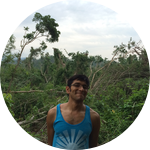About This Project
Bird nests are the first environment where a baby bird will hatch and grow, making it a super important place. However, birds don't grow in there alone. Millions of microbes are also sharing the nest environment and get in contact with the little chicks. I want to know what microbes are there and which ones can affect the bird growth and development, including not only the bad microbes but also the beneficial ones! Let's find out if birds are constructing nests that house healthy microbes.
Ask the Scientists
Join The DiscussionWhat is the context of this research?
We live surrounded by microbes. We know that some of them can be harmful but actually many of those microbes form tight beneficial associations with us and other animals. These microbes can affect and even promote many functions like development, digestion and immune function. We know that our associated microbes (our microbiota) are very important but we still don't know how animals acquire all of those tiny partners. There have been a number of studies on lab animals but few people have actually searched for microbes in the wild. In my project I traveled to the rain forest of southern Mexico and sampled the microbes of baby birds.
What is the significance of this project?
This study aims to answer: where do our microbes come from? Animals are born with very few microbes. Therefore, by sampling baby birds I was able to collect the initial microbial stock that was slowly colonizing them. I included different bird species that construct different nest types. Each of those nest types provide different environments, meaning that those little chicks will grow with different microbes. At the end I'm going to be analyzing the effect of nest type on the microbial communities that are associated to birds early on their life. We will know how much it affects to be born on nest type A vs nest type B. This will help to understand what contributes more to our initial microbes: our parents (and their parents) or the place where we were born?
What are the goals of the project?
I already did all the field work, including finding the nests and taking the microbial samples. This was done with the help of local students, it's really hard to find bird nests in the rain forest! We were able to sample 36 nests more than 2 times. By sampling the same birds several times I will be able to track the changes in the bird's associated microbes throughout their growth. We took samples from the nest, the chick's skin and poop. However, I still need to analyze all of those samples. The first step is to extract the DNA preserved in them. Then, I'll be using the 16S gene (like a bar code for microbes) to quantify and identify the bacteria on each sample. After that I'll compare the microbial communities between birds and nests to see how similar they are.
Budget
Finding the nests on the jungle was really hard, but that part is over. Now I need to process the roughly 500 samples collected. First, I need to extract the DNA from the microbes on my samples. Extracting DNA can be tricky and different methods can lead to different results. Comercial kits have been developed to try to minimize such bias. Using a comercial kit will make my results comparable to other studies.
After getting the DNA, I will focus on a specific gen commonly used to identify bacteria: the 16S ribosomal gen. This gene is present in all bacteria but with slight variations on each species. By using next generation sequencing (MiSeq Illumina seq) I'll be able to identify the bacterial species on each sample.
It's important to know which bacteria are present, but it's also important to know their abundance. Using Quantitative PCR (qPCR) I will be able to count the number of 16S genes on each sample as a measure of bacterial abundance.
Endorsed by
Meet the Team
Felipe Campos Cerda
I'm a PhD candidate at the University of Oregon. I grew up in tropical Mexico and have been always amazed by nature. After working with bird nests for 8 years I started to wonder how important it would be to have the right partners while growing up. For a baby bird, the nest microbes are those partners and as a bird parent it would be critical to provide the best microbes for your offspring. Now I have the chance to study that system, thanks for helping and being part of the project!
Lab Notes
Nothing posted yet.
Additional Information
Project Backers
- 7Backers
- 5%Funded
- $184Total Donations
- $26.29Average Donation

